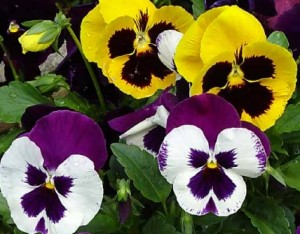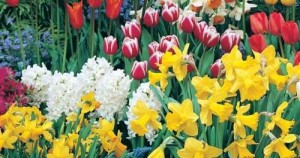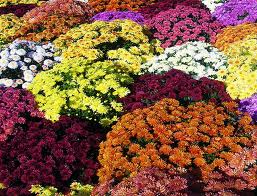Did you ever consider having three full seasons of color on your property? You can, and it’s fairly easy! By using early to late bulbs in spring, annuals in the summer and mums in  the fall- plus your flowering trees and shrubs- you’ll have non-stop color almost year-round. Here are a few tips that may make your personal “flower show” more successful.
the fall- plus your flowering trees and shrubs- you’ll have non-stop color almost year-round. Here are a few tips that may make your personal “flower show” more successful.
There are two basic ways to plan floral displays. You can go for the maximum visual impact or “wow appeal” by having a few massive beds of one or two types of flowers. The challenge with this approach is that in trying to keep the gardens fresh, you need to eliminate the spring bulbs before planting the summer annuals. And then do the same again in the fall when the chrysanthemums are ready to become your focal point. This process is more work and can be more expense, but you can really knock the socks off your guests and neighbors with massive flows of color.
The second basic approach is to plant your flowers in a border-type bed of mixed types of  plants. With this approach, you will mix all of the different kinds of flowers through the season, so that as your bulb foliage dies down your annuals begin to thrive and help cover the browning bulb leaves. Many gardeners find this approach more enjoyable for the variety it delivers year round. And you can include small shrubs and perennials as well. Planning a great mixed garden takes careful planning with consideration of blooming times and height of the different plants chosen.
plants. With this approach, you will mix all of the different kinds of flowers through the season, so that as your bulb foliage dies down your annuals begin to thrive and help cover the browning bulb leaves. Many gardeners find this approach more enjoyable for the variety it delivers year round. And you can include small shrubs and perennials as well. Planning a great mixed garden takes careful planning with consideration of blooming times and height of the different plants chosen.
The hardest part of creating a floral show comes first- improving the soil. As with all kinds of gardens the old saying also holds true for flowerbeds, “for every dime you spend on plants, put ninety cents into the soil.” Incorporate organic materials and lots of it. You can use compost, rotted manure, peat moss or any combination of these. Just be sure it’s mixed in really well and deep.
Once the soil is ready, the fun can begin! In selecting your spring bulbs, the choices are enough to boggle the mind. And since most bulbs bloom either early spring, mid-spring or  late spring, you can have a succession of beauty and enjoyment just from the bulbs you select. It’s good to be aware that some bulbs (like daffodils) continue to multiply and stay vigorous from year to year while others (like tulips) tend to dwindle in quantity and quality if not pulled out and separated each year. A great feature of bulbs is that most get planted in the fall, so all winter you can imagine the show you’ll have in the spring.
late spring, you can have a succession of beauty and enjoyment just from the bulbs you select. It’s good to be aware that some bulbs (like daffodils) continue to multiply and stay vigorous from year to year while others (like tulips) tend to dwindle in quantity and quality if not pulled out and separated each year. A great feature of bulbs is that most get planted in the fall, so all winter you can imagine the show you’ll have in the spring.
There is also an abundance of summer annuals from which to choose. Be sure to select annuals that will work well in the amount of sun your garden gets and how well you’ll be able to water during hot, dry periods.
Even though most annuals will keep blooming until cold weather, extending the fall with one more change is exciting. Like all the plants we’ve been talking about mums come in a variety of size, color and texture. The standard garden mum is a good performer almost every year. From rust to deep reds and bright yellows and whites, grouping of three or five plants (or more) add a vast burst of color to an almost-finished season.
The great thing to remember is that you can “jump onboard” during any season and enjoy the wonderful feeling of watching something you’ve planted grow!


